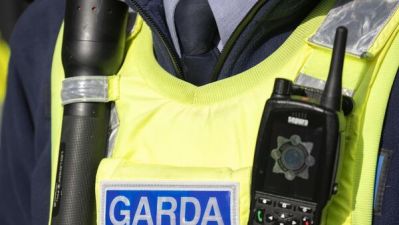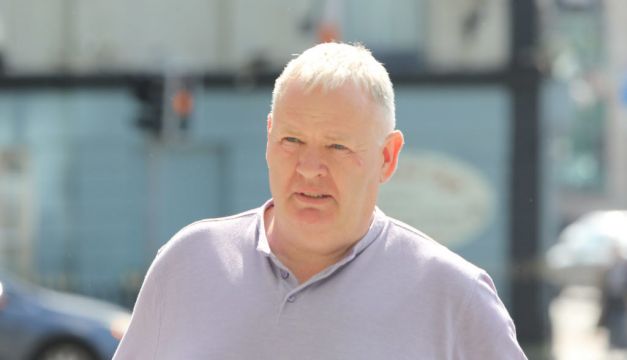The prosecution case against a Donegal builder accused of being part of a group of men who attacked security guards at a repossessed farm house is deeply flawed, contaminated and devoid of fair procedures, a court has heard.
Patrick J Sweeney (44), of High Cairn, Ramelton, Co Donegal, is one of four men on trial for their alleged roles in the early morning attack at the rural property at Falsk, just outside Strokestown, Co Roscommon on December 16th, 2018.
The jury at Dublin Circuit Criminal Court has heard evidence from four security guards that a group of around 30 men arrived at the house at around 5am. They were armed with weapons including a baseball bat, a meat cleaver, a hurley, a stick with nails in it and a chain saw and attacked the men present.
Mr Sweeney is charged with false imprisonment and assault causing harm to four security personnel, aggravated burglary, arson of four vehicles which were set alight, criminal damage to the front door of the house, violent disorder, robbery of a wristwatch from one security guard and finally, causing unnecessary suffering to an animal by causing or permitting an animal to be struck on the head.
The prosecution evidence is that Mr Sweeney is identifiable on footage of the attack recorded on a body-cam worn by security guard Mark Rissen and that he is the man wearing a hunter's hat and wielding a chain saw. Images found on his mobile phone, including a screenshot of a map from Ramelton to Roscommon, also allegedly link Mr Sweeney to Falsk in and around the time of the attack.
His co-accused Martin O'Toole (58), of Stripe, Irishtown, Claremorris, Co Mayo; Paul Beirne (57), of Croghan, Boyle, Co Roscommon, and David Lawlor (43), of Bailis Downs, Navan, Co Meath, are charged with the same 17 counts. All four men have pleaded not guilty to the charges. The trial is in its closing stages.
'Full of innuendo'
On Thursday, Patrick McGrath SC, defending Mr Sweeney, made a closing speech to the jury. He said the State's case was general, vague and full of innuendo and while it was presented with remarkable confidence, “it mirages away” when pressed and tested.
He said gardaí had failed in their duty to properly preserve the body-cam evidence. He said the jury were only shown 37 seconds of footage from one body-cam on the night where there were multiple body-cams, some of which have been found.
Mr McGrath told jurors the evidence of Mark Rissen and his colleague John Graham about who was in the kitchen at the time the video footage was allegedly recorded, was utterly conflicting.
He said in his original statement in 2018, Mr Graham said nothing about being in the kitchen during the attack and only states that he was there in a follow-up statement made last March, when he was shown the 37 seconds of footage. In that statement, Mr Graham said he was in the kitchen with Gary McCarthy and that Mark Rissen was not in the kitchen.
Mr McGrath told the jury that the State was asking it to ignore Mr Graham's original statement and to ignore from his second statement the detail about Mr Rissen. He said this evidence was “all over the place”.
In his statement, Mr Rissen told gardaí he was in the kitchen when armed men came in wearing high-vis vests and balaclavas and scarves over their faces. He said one man was holding a chainsaw and a pickaxe handle, and he had a “browny … big bushy beard”.
Mr McGrath told jurors that the prosecution is asking it to consider whether the hat may or may not be the bushy beard, despite nobody saying this in evidence. He said the man in the footage cannot be Mr Sweeney.
He said that the way in which a garda from Ramelton identified his client on the footage did not follow protocols now in place for gardaí identifying CCTV. He said these protocols were there to minimise the risk of error and were in place at the time for civilian witnesses identifying CCTV.
Garda procedures
Counsel said gardaí can make mistakes in the same way as civilian witnesses and if these protocols are needed now for gardaí, then they were clearly needed back in 2019.
“Their [the gardaí’s] powers of observation has not improved since then. It cannot be right that Mr Beirne has been deprived of these fair procedures,” Mr McGrath said.
He added there are inherent contradictions in the accounts given by Detective Garda Enda Jennings of his identifying Mr Sweeney from still images on a bulletin board.
Mr McGrath said that when Det Gda Jennings came to view the body-cam footage in the office of Det Inspt Pat O'Donnell, he was left alone with a laptop which had the footage attached to an email. The email was open and contained the words, “Pat, as discussed for identification purposes. As you know PJ Sweeney from your area has already been arrested for this...”.
“It’s hard to imagine a greater case of suggestion. The identification process is devoid of fair procedures and contaminated from the off,” Mr McGrath said.
He said Det Gda Jennings had placed great emphasis on the hunters’ hat, but he said the hat found in his client's house and produced as evidence could not be the hat worn by the man on the body-cam footage. He said Mr Sweeney's hat had a hard peak and no fur while the one in the footage has a soft peak and no fur and is a different colour.
Mr McGrath said that there was not a single piece of evidence linking his client to the other defendants. He said that although Mr Sweeney is supposed to be part of this group of people who made plans and conspired, there is nothing on any of the six phones taken from his home between him and the co-accused.
He said his client provided fingerprints and DNA samples, but there is no forensic evidence linking him to the scene. He told the jury that the body-cam footage shows the men in the kitchen in Falsk were not wearing gloves.
Mr McGrath said the prosecution had stated with absolute certainty that the images allegedly taken around Falsk around the time of the attack, including the route map from Donegal, had been taken with the iPhone 7 found in his client's home.
He said there is no evidence Mr Sweeney even had this iPhone 7 in December and that the prosecution evidence that the images were downloaded from Mr Sweeney's “cloud account” onto the new phone was “utter speculation”.
“We do not know how these images got on this phone. That is not good enough in a case this serious,” Mr McGrath said.
He added this was a fundamentally flawed prosecution case where the jury was being asked to speculate and to ignore evidence that does not fit the State's theory. He said the garda investigation was deeply flawed, obvious things were not done and the evidence does not match the standard where a jury could find someone guilty beyond reasonable doubt.
Paul Beirne defence
Later on Thursday, the trial heard the closing arguments from Andrew Sexton SC, the defence counsel for cattle dealer Paul Beirne (57).
Mr Sexton told the jury that Mr Beirne is an "ordinary local person" who was involved in his community. He said his client had a "specific plan" to "retake the premises" which he told gardaí about voluntarily.
Mr Beirne told gardaí he went to the house with the aim of taking back the house peacefully but that things got out of control. The State's case is that he organised and participated in the events on the night and he brought men there in his cattle lorry.
Mr Sexton said Mr Beirne told gardaí that his role was to "put the door in with the sledgehammer". Events after this were "not part of any plan" and were not condoned by his client, counsel said.
Counsel said it was "clear there was going to be a robust exchange taking the property back" as it was "not occupied by choirboys", but "people brought in at the behest of the bank via Trinity Asset Management".
"People had different designs," he said and events "went out of control".
"The plan of one person may not have been the plan of the other," Mr Sexton said, noting that his client is "not his brother's keeper".
Mr Sexton there is no evidence to connect Mr Beirne to any of the assaults, to the fatal injury of a guard dog, or to the burning of the vehicles. He noted that some of the vehicles belonged to the McGann family and his client "is hardly going to arrange for the burning of his friend's vehicles".
Counsel said the only offence for which there is evidence against his client is the criminal damage of the front door, as Mr Beirne told gardaí that he used a sledgehammer to put the door in. However, Mr Sexton said the offence of criminal damage allows for a defence where the accused has the consent or believed he had the consent of the owner.
He said in this case, Mr Beirne believed that Mr McGann was still the lawful owner who had been wrongfully evicted and that he had or would have had Mr McGann's consent to enter the property by force.
He said that McGann ended up back in the house afterwards, and that his client saw this as “a neighbourly situation” in which he was facilitating the re-entry of the McGanns back into the property.
“He genuinely believed it. He was trying to right a wrong. If you are satisfied of that, you must acquit,” Mr Sexton said.
He told jurors that the footage recorded on the day of the eviction shows numerous people are shouting “no order” to the court messengers. He said the execution of the possession order was fundamentally flawed and illegal and this went against the inviolability of a citizen's private dwelling, as set out in the Constitution.

He said that the evidence shows that a Garda Superintendent, the bank and the county registrar were "deeply involved in this little family property down in Roscommon". Mr Sexton asked the jury: "What on earth is going on?"
He said this is an "unusual" and "bizarre" case which is "dreadful in ways". However, he added, that is "no reason for you as jurors to say 'that's it, a plague on the house of Mr Beirne'."
"He did what he did. It has caused terrible ramifications, but they are not criminal," he added.
The trial continues.







